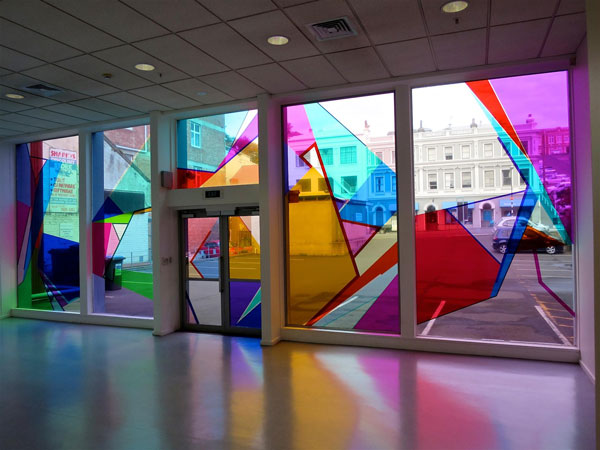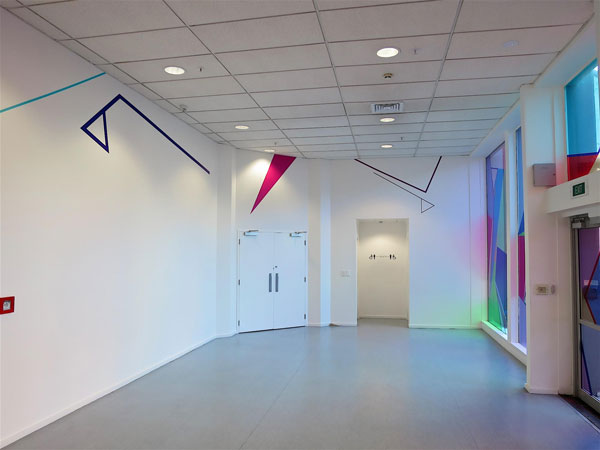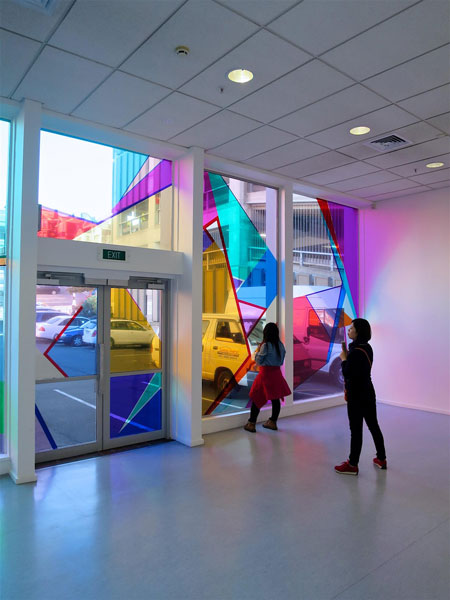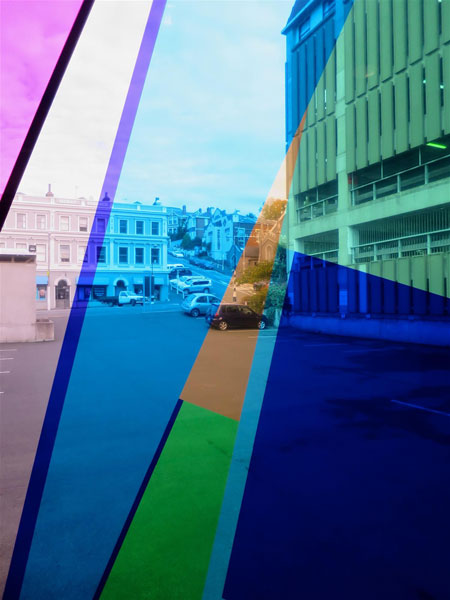Gregory Minissale
While the novice senses a beautiful idea the imperial astronomer elaborates a vision of a celestial physics come down to earth in the form of music. The notion of the music of the spheres, passed down from Plato to Pythagoras, Boethius and Kepler, continues to pattern the imagination and various artistic practices that snag its rhythms and proportions.
Yet it is rhythm that is more fundamental than music; it travels across unbounded space and is translated and elaborated by the senses and cognition into musicality. These processes undergo further changes and contractions when parsed and translated into digital or semiotic structures. There is a kind of descent or clinamen where abstract rhythm ‘out there’ affects and is affected by the senses in an analogue world, and is then captured and transformed by digital, geometrical, and semiotic codes.

Shannon Novak, Arrhythmia Detail I, 2017. Permission of the artist.
Shannon Novak’s installation The Expanded Gallery at the Dunedin Public Art Gallery arranges some of these ideas. The large vestibule window, overlaid with warped triangles of different colours and sizes that resemble stained glass, is a nonlinear dynamic way of beholding the light. The pattern seems to alternate short and long jazz breaks, somewhat reminiscent of the jazz-inspired paintings of Stuart Davis. They seem to share a similar twitchiness. The light shining through the colored glass is filtered onto the interior walls but this dispersed optical flow is halted by geometrical compositions that the artist has fixed onto the wall and ceiling intersections. Understood as diacritical figures or accents they seem to notate unexpected intervals in the architectural vocabulary. Musicologist Michael H. Thaut writes that the accent is ‘an important expressive device in the timing architecture of music’.[1] Accents create differentiations in abstraction at the same time as striations in the smooth space of the white walls. Accents create rhythmic pulse patterns in the kinaesthetics experienced by the viewer captured within the language of architecture. The diagram does not represent but helps to produce complex rhythms across brain, body and world.
Memories tend come and go in the present perception space. The coming and going is rhythmic. Shannon Novak’s modernist geometrical language, in a range of past works, can be compared with Malevich’s Dynamic Suprematism (1915), Klee’s Insula Dulcamara (1938), and Kandinsky’s Composition VIII (1923). This is so in terms of the holistic view rather than in the fine-grained focal points. The energy signature Shannon’s geometry often suggests is compact and resting in itself. Yet its transposition into the architectural and the digital, with the roll-out of works into multiple sites such as a newspaper and school, disperses the opticality of modernist painting into a broader economy.
The geometrical diagrams appear ‘grammatical’ with repeat particles-signs that seem to form a limited set, rotated, causing mental rotations (in the sense of reading a map or turning the map around). They stimulate ‘reading’ routines within an architectural space that is already coded, and they offer opportunities to re-code again in the sphere of the digital where smartphones ‘machine read’ the geometric compositions to offer musical notes in reply. In this sense a fundamental ‘musicality’ propagates across the sensorimotor, technological and cognitive spheres to complicate rhythm. In The Expanded Gallery the geometry is placed above forcing one to look up. This may activate a kind of muscle memory that supports a vision of astronomical maps tracing constellations or cosmic trajectories slipping out of view. The phenomenology is tilted into Dr. Caligari territory, but in a diagrammatic way, by abstracting from the details and capturing similarly disorienting relationships of angles and orthogonals. At the root of all this is a kind rhythmic torsion of concepts and sensations.

Shannon Novak, Arrhythmia Detail XI, 2017. Permission of the artist.
Danijela Kulezic-Wilson[2] identifies in the work of French composer Michel Chion the theory of ‘transsensorial perception’ which is ‘neither specifically auditory nor visual as it becomes decoded in the brain as rhythm after passing the sensory path of the eye or ear.’[3] This suggests that rhythm is fundamental and abstract; it is continuous matter and movement before being divided by the senses. Shannon seems to agree: ‘rhythm is split – synaesthesia allows one to experience rhythm before it is split.’ It may well be that artists have a privileged access to this matter-movement before it has been contracted or channelled into the different objects, percepts, shapes and forms that fill our sensory world. On this view the artist’s lines and geometries seem isomorphic with the energy and matter-flows of rhythm rather than representations of them. Shannon explains in a recent interview:
In Acoustic Synergy, I wanted to create a space or world that encouraged interdisciplinary activity. I invited visual artists, poets and mathematicians to freely respond to the work. I often take this approach to try and reconnect that which I feel has been separated and might benefit from reconnection… I aim to create worlds that bring the senses closer together.[4]
There are echoes here of the traditional notion of the Gesamtkunstwerk by which artists aimed to reconnect the senses into sequences of unity to arrive at some kind of transcendence. But it is often forgotten that there are more disorderly experiments that overlap multisensory experience, equally important, such as the improvisations of jazz. Perhaps there are different rhythms that run deeper than the senses. There might be an Apollonian pursuit of ideal forms and geometries; there could be a Dionysian tendency drawn towards sensuous chaos. Yet there are some artworks that suggest a struggle between these forces. In literature James Joyce used the term ‘chaosmos’ to describe a coming together of order and disorder, rules and freedom, cosmos and chaos. For him these forces were not opposites but part of a larger continuum. Rather than looking to art for order we can also descend into subliminal polyrhythms. On this view reconnecting the senses would be more like synaesthesia but with certain unexpected rhythms and breaks, ‘pragmatic entrances into unconscious formations,” a momentary “submersion in a chaotic immanence’.[5]

Shannon Novak, Arrhythmia Detail III, 2017. Permission of the artist.
Shannon Novak writes:
The Dunedin Public Art Gallery work is less linear, and more jazz oriented. I was taught classical piano then modern piano and finally jazz (the art of improvisation). I combined all three styles into my own which on first listen may sound classical but relies on a lot of improvisation. I don’t notate my music, I simply put cues for it such as musical note letter names (like “A”) and play from that. This is the scripted side of my work as a composer. The non-scripted is pure improvisation, like the piano performance I’m giving at the Dunedin Public Art Gallery. It’s a direct translation of the environment into piano speak. I thought this to be one of the most accessible and direct ways for the audience to experience synaesthesia.[6]
It is not easy, however, to release the work of art from its axiological burden: its duty to signify a story or deliver a message. We sometimes forget that vision is not only for rational or purposeful searching of the environment. Openness to mind wandering, pulsed by the contingencies of sound, vision, space and time, allows things to come into view.
One slips in and out of conscious and nonconscious moments along the lines of jazz. A well-known study of six jazz pianists by Limb and Braun discovered that when musicians improvise and create spontaneous musical passages their brains’ highly conscious analytical and rational planning areas associated with the ‘executive’ system are deactivated. Limb and Braun suggest that this deactivation “may be associated with defocused, free-floating attention that permits spontaneous unplanned associations and sudden insights or realizations…to arrive at a solution without reasoning.” And this deactivation, they report, is also ‘responsible for altered states of consciousness such as hypnosis, meditation or even daydreaming’.[7]

Shannon Novak, Arrhythmia Detail IV, 2017. Permission of the artist.
Once, Jasper Johns described his American flag painting, White Flag (1955) as a change in rhythm: ‘The change has two speeds. In the stars its allegro vivace, agitated movement, flickering and exploding. In the stripes it’s andante’.[8] Metaphors are interesting things, not least because they point to feelings that stretch across the boundaries between the senses. And yet in no way is this just fanciful. There are ways in which neuronal excitation patterns would light up with so much information in the stars. The pointed edges in all directions would cause different mental rotations and would put tactile responses on alert. All these might return to relative order following the repetitive, calming rhythms and smooth contours of the stripes. And one can switch from stars to stripes, and back again. We can also elaborate with surface effects and the transparencies of the waxy layers (with notions of decay and preservation which also attend the work). It’s not just that Johns described a fixed medium in terms of movement, or apportioned different speeds to the stars and to the stripes, it’s that both speeds and rhythms are stimulated by the same work. These complications of rhythm arise as a ‘felt abstraction’ over and above or underneath the literal identification of ‘the image’ of the American flag.
In the reverse direction Thaut mentions that it is common for spatial images to arise listening to music:
Sound durations can express extensions and distances; rhythmic and melodic contours can express images of lines and geometric figures; vertical stacks of sound can evoke pictures of multidimensional forms and layered objects.[9]
Shannon Novak’s geometric compositions also stimulate edge detection, mirror neurons, mental shape rotation, vertical and horizontal thrusts, chromatic salience and various tensions in figure-ground ambiguities – all of which do not simply function as tools for identifying an image. We may defer meaning and tarry with concepts and sensations set in motion by this geometrical multistability. The complexity of audio-visual rhythm arises both as itself and abstract over and above any consideration of melody, motif or story. Perhaps the artist’s intention to ‘play the room’ and improvise on the piano with jazz breaks, physically nesting his body within his own artistically composed setting, will communicate a latter-day music of the spheres. If it does so, as Bachelard would say in the Poetics of Space, perhaps it’s because we have prepared a special place for it in our own oneiric topologies.[10]
[1] Thaut, Michael. Rhythm, Music, and the Brain: Scientific Foundations and Clinical Applications (London: Routledge, 2013), 10.
[2] Danijela Kulezic-Wilson, The Musicality of Narrative Film (London and New York: Palgrave Macmillan, 2015).
[3] Chion, Michel. Audio-Vision: Sound on Screen (New York: Columbia University Press, 1994), 40.
[4] Novak, Shannon. Manhattan Phrase 40.74279-, .74.008981 to 40.728411,-73.975679 (Auckland: Chartwell, 2014), 32.
[5] Félix Guattari, Chaosmosis: An Ethico-Aesthetic Paradigm (Sydney: Power Publications: 1995), 68.
[6] E-mail communication with the author, 05/04/17.
[7] Charles J. Limb and Allen R. Braun, ‘Neural Substrates of Spontaneous Musical Performance: An fMRI Study of Jazz Improvisation’ Plos One, 2008 http://journals.plos.org/plosone/article?id=10.1371/journal.pone.0001679
[8] Sylvester, David. About Modern Art: Critical Essays, 1948-1997 (New York: Henry Holt, 1997), 464.
[10] Gaston Bachelard, The Poetics of Space (Boston, MA: Beacon Press, 1994).
Gregory Minissale is Head of Art History at the University of Auckland and author of The Psychology of Contemporary Art (Cambridge: Cambridge University Press, 2013).